No, I’m not counting that appearance in Super Friends.
So on the DC Daily show on the DC Universe streaming channel, they do a thing called “Book Club” (“tally-HO!”) in which several of the cast members discuss a storyline or series of comics, a few issues at a time over a number of episodes. It’s a thing to encourage viewers to read those same stories via the DC Universe digital comics library. The discussions are fun and spirited and entertaining to watch, and if you like comic books, like I know I do, it can be nice to watch a bunch of folks enthusiastically and positively chatting about funnybooks I like.
And speaking of which, the current Book Club reading material of choice is Alan Moore’s Swamp Thing, which of course certainly grabbed my attention. They started with the initial four issue storyline (plus a brief aside to #20, Moore’s first actual issue on the series), in which Swamp Thing discovers his true nature (or does he?) and squares off against the old Silver Age super-villain the Floronic Man.
Now, there’s a certain aspect to that story I kept expecting someone on the show’s panel to mention, but either they didn’t have time (it’s only a 15-minute or so segment, after all) or, speaking as an old person, perhaps they were just a bit too young to realize what a big deal this was. This is the storyline that just straight up puts the Justice League of America into a horror comic, and manages to make them fit into tonally into the proceedings, and what a precedent-setting event that was.
Swamp Thing, of course, had interacted with the larger DC superheroic universe at large prior to this, most famously in issue #7 of the original 1970s series where Batman appeared. Eventually there would be appearances in DC’s team-up books (twice more with Batman in Brave and the Bold, once with Superman in DC Comics Presents), plus an extended guest-starring role in Challengers of the Unknown.
The Batman appearances seemed more in line with Swamp Thing’s particular milieu, while the Superman adventure was more an off-model Swampy story (more like a bright super-adventure than one of DC’s mystery books). (EDIT: since there’s confusion, I’m referring to the 1979 Superman team-up by Steve Englehart and Murphy Anderson, not the later one by Moore and Rick Veitch). The Challs stuff was kind of a mix of the two, closer in style to the “weird heroes” DC comics of the late ’60s. What they all had in common was that they weren’t really trying to…re-present, I suppose, the superheroes in any sort of new context vis-à-vis the tone of a Swamp Thing story. These were generally straight-forward superhero adventures, and also here’s Swamp Thing. Batman feels like the closest fit mostly due to the usually darker nature of his own stories, especially in the post-1960s attempts at escaping the long shadow of the Adam West TV show.
When the second Swamp Thing ongoing series began in the early ’80s, the stories once again felt divorced from the DC universe. There were Phantom Stranger back-ups in the early issues, but were unrelated to the lead feature. Mr. Stranger would of course eventually team-up with Swampy in issues #14 and #15 of that series…possibly a more natural fit than even Batman, given the character’s supernatural nature.
So anyway, back to that Justice League appearance. That happens in issue #24. In issue #21, we get sort of our first hint of what’s to come with the introduction of Jason Woodrue, AKA the plant-themed super-villain the Floronic Man into the series. This is not a transgressive introduction of a superheroic element into the Swamp Thing comics, but rather Woodrue is redefined in horror terms, a twisted, shadowy monster instead of a sleekly costumed nemesis for the Atom or whomever. Swamp Thing isn’t made to fit into a superhero book (like he had been before, especially in that one Superman team-up)…it’s his book, these visiting characters have to play by his book’s rules. And the main rule is “you’d better be unnerving.”
Which finally leads us to the Justice League appearance. When issue #23 contained the line “and Washington called the Justice League,” I remember thinking at the time “whoa, hold on, this is Saga of the Swamp Thing, how the heck is the JLA gonna fit into this?” Y’know, despite the fact that we’d been reading about an old supervillain for the last couple of issues, but he fit in…he was a plant-monster, kinda like Swampy, he was creepy and murderous and didn’t feel like a goofy 1960s villain. But the Justice League, with, like, Superman and Firestorm and such, that seemed like a bridge too far.
But here it was, issue #24:
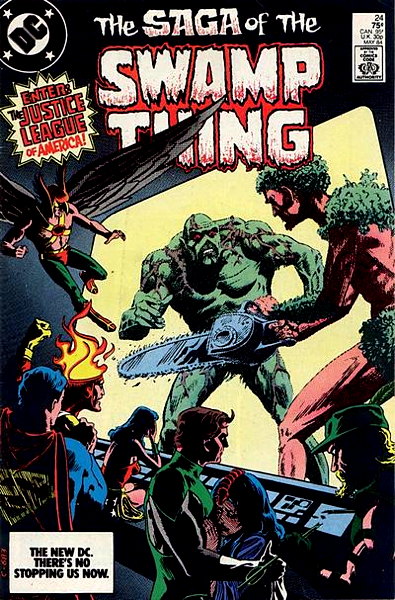
…with a cover blurb and everything, which you mostly didn’t get on the more horror-oriented Swamp Thing covers. And already you can see that this isn’t going to be a usual guest-appearance by Earth’s Greatest Super-Team, what with them being all dark and shadowy and stuff.
And sure enough, inside, they’re….all dark and shadowy and stuff. And the captions aren’t all flowery and upbeat and “hey look, it’s your favorite heroes.” It’s more along the lines of “these are weird beings dressed in strange ways and can do not-normal things.” Well, hold on, here are some representative panels:
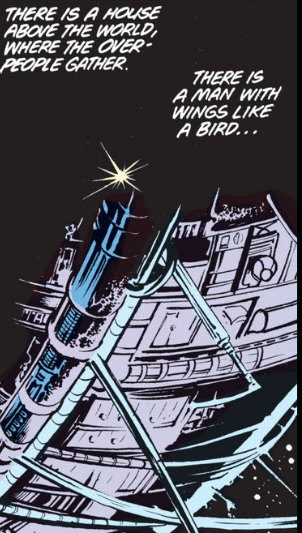
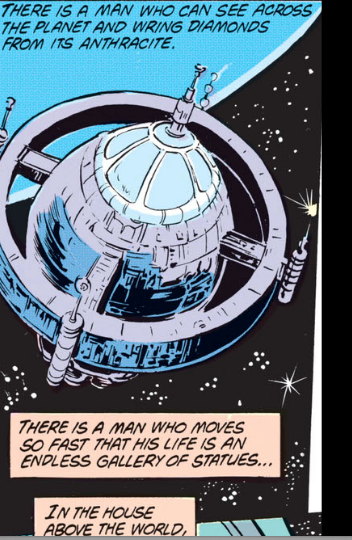
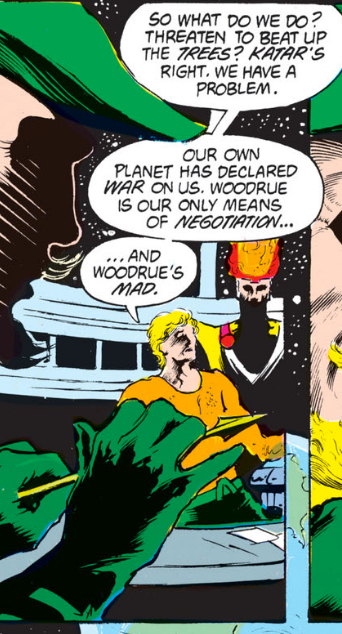
I mean, they’re not even called “superheroes,” but the somewhat more terrifying “overpeople,” for Pete’s sake. You’re forced to reexamine these characters in the title’s horror context, helped along by the shadows and the coloring and their non-conventional portrayals…what is usually idealistic heroism is now creepy and a little upsetting.
Alan Moore had already been reexamining (or “deconstructing,” if you will) the superhero genre over in England with his earl 1980s reintroduction of original Captain Marvel 1950s knock-off Marvelman. What was once bright and cheery with that character is now menacing and mired in modern day government conspiracies and violence. But the JLA’s appearance in Swamp Thing set the tone for nearly all future appearances of superheroes in this series. They’re never just “as-is,” it’s always in the context of “what’s wrong with this,” or “here’s what’s really odd about them,” or “did you ever realize this?” They’re all recontextualized in the comic’s tone, designed to make you see them differently, to reconsider them, to be kept off-balance by them. Even when the metacommentary gets a little too much for DC editorial, requiring some changes, the “scary superhero” continues throughout the run.
And this idea of reexamination/deconstruction spread to other comics, especially the Vertigo and proto-Vertigo titles like Sandman (itself using an Justice League villain as one of its initial antagonists) and Shade the Changing Man and Doom Patrol (which could be argued that, to an extent, it was sort of approaching this level of “superhero as an other to be feared” even back in the 1960s run). But I think it’s same to say this portrayal of the JLA was, as was described to me when I talked about this briefly on Twitter, one of “the most influential comics ever published.” It’s one of the first of the modern era of mainstream superhero comics to make us look at these characters in a different and disturbing light.
And that’s the thing I think was missed on the DC Daily discussion, just how surprising and shocking this version of the Justice League was. That sort of portrayal is more commonplace in comics now, but it was certainly novel back then. Pretty much a straight line from this to Watchmen, I think it’s safe to say.
Speaking of the DC Universe digital comics ( which I was way back at the beginning, if you remember)…if the DC Daily crew were reading this storyline via that digital library, I hate to tell them but they missed the very last line of the Floronic Man story. Like some of the print editions (previously: 1 2), the line “…and meet the sun” is dropped off that final splash page:
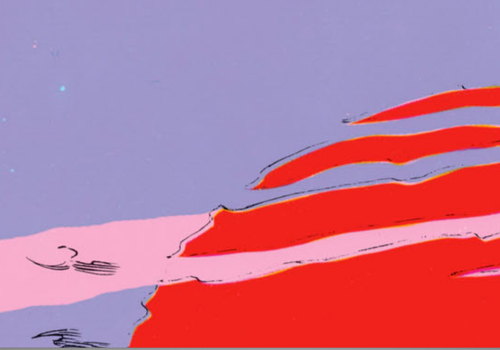
Along with that color-hold error in the digital #21…well, I don’t know what to tell you…you folks should have bought ’em off the stands back in ’83, like I did.
nbsp;
ADDENDUM: I was also reminded on the Twitterers that we had some measure of Swamp Thing absorbing superheroic shenanigans into its milieu near the end of the original series, as well as a promised (but never published) appearance by Hawkman. This was, if not an influence, at least a precursor to what was to come. Oh, and Steve Gerber’s Man-Thing work in the ’70s should be part of this lineage as well, what with that Foolkiller character an’ all. But holy cow, I’ve typed enough tonight…further coverage to come, I’m guessing!
nbsp;








I’ve always loved Superman’s line about counting the atoms in the atmosphere.
Glad to see the mention of Doom Patrol. I’ll never forget the JLA’s appearance in Morrison’s version of that book, where they were more useless than anything else. It takes a special kind of person to unravel the weirdness of the Doom Patrol’s adventures, and the JLA didn’t cut it — too “square.”
Frankly, Cliff barely made the cut most of the time. The day was usually saved by the traumatized lady with 64 personalities (all with accidental superpowers) or the alchemically fused doctor/pilot energy being. That’s how weird you had to be to accomplish anything worthwhile in that book.
Ha ha, you’re just bursting with comics-related thoughts after weeks of not being able to post regularly on here, aren’t you Mike
Seriously, great post though.
Did you completely forget about DC Comics Presents 85 with Superman and Swampy? I love the way Moore plays up the alieness of Superman.
Damien – no, I was just focused on listing the pre-Moore DCU appearances of Swamp Thing. DC Comics Presents #85 definitely falls into that post-Saga of the Swamp Thing #24 period of that modern reconsideration of DC’s superhero characters.
That makes sense.I was worried for your memory.
Damien – my memory’s fine, my ability to catch typos is in some question, however!
This was actually my first issue of the Bissette/Totleben/Moore run, a few years after the fact, around 1988. Not sure how I happened to pick it up, but fortunately by that time the first collection was out, and was one of the first tradepaperbacks I picked up, and one of the first back-issue hunts I went on was trying to get the rest of the run.
One of the most striking things was how almost none of the codenames was used. It’s all “Katar” and “Kal” and “Hal”. I think the exception was Raven from the Titans (who Ollie calls “Blackbird”), and I guess technically that is her real name.
I can’t believe that the final caption is still missing after all these years. Is it at least fixed in newest print editions?